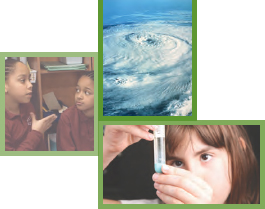
Science, engineering, and technology permeate nearly every facet of modern life, and they also hold the key to meeting many of humanity’s most pressing current and future challenges. Yet too few U.S. workers have strong backgrounds in these fields, and many people lack even fundamental knowledge of them. This national trend has created a widespread call for a new approach to K-12 science education in the United States.
The Committee on a Conceptual Framework for New K-12 Science Education Standards was charged with developing a framework that articulates a broad set of expectations for students in science. The overarching goal of our framework for K-12 science education is to ensure that by the end of 12th grade, all students have some appreciation of the beauty and wonder of science; possess sufficient knowledge of science and engineering to engage in public discussions on related issues; are careful consumers of scientific and technological information related to their everyday lives; are able to continue to learn about science outside school; and have the skills to enter careers of their choice, including (but not limited to) careers in science, engineering, and technology.
Currently, K-12 science education in the United States fails to achieve these outcomes, in part because it is not organized systematically across multiple years of school, emphasizes discrete facts with a focus on breadth over depth, and does not provide students with engaging opportunities to experience how science is actually done. The framework is designed to directly address and overcome these weaknesses.
The framework is based on a rich and growing body of research on teaching and learning in science, as well as on nearly two decades of efforts to define foundational knowledge and skills for K-12 science and engineering. From this work, the committee concludes that K-12 science and engineering education should focus on a limited number of disciplinary core ideas and crosscutting concepts, be designed so that students continually build on and revise their knowledge and abilities over multiple years, and support the integration of such knowledge and abilities with the practices needed to engage in scientific inquiry and engineering design.
The committee recommends that science education in grades K-12 be built around three major dimensions (see Box S-1 for details of each dimension). These dimensions are
• Scientific and engineering practices
• Crosscutting concepts that unify the study of science and engineering through their common application across fields
• Core ideas in four disciplinary areas: physical sciences; life sciences; earth and space sciences; and engineering, technology, and applications of science
To support students’ meaningful learning in science and engineering, all three dimensions need to be integrated into standards, curriculum, instruction, and assessment. Engineering and technology are featured alongside the natural sciences (physical sciences, life sciences, and earth and space sciences) for two critical reasons: (1) to reflect the importance of understanding the human-built world and (2) to recognize the value of better integrating the teaching and learning of science, engineering, and technology.
The broad set of expectations for students articulated in the framework is intended to guide the development of new standards that in turn guide revisions to science-related curriculum, instruction, assessment, and professional development for educators. A coherent and consistent approach throughout grades K-12 is key to realizing the vision for science and engineering education embodied in the framework: that students, over multiple years of school, actively engage in science and engineering practices and apply crosscutting concepts to deepen their understanding of each field’s disciplinary core ideas.
The framework represents the first step in a process that should inform state-level decisions and provide a research-grounded basis for improving science teaching and learning across the country. It is intended to guide standards developers, curriculum designers, assessment developers, state and district science
BOX S-1
THE THREE DIMENSIONS OF THE FRAMEWORK
1 Scientific and Engineering Practices
1. Asking questions (for science) and defining problems (for engineering)
2. Developing and using models
3. Planning and carrying out investigations
4. Analyzing and interpreting data
5. Using mathematics and computational thinking
6. Constructing explanations (for science) and designing solutions (for engineering)
7. Engaging in argument from evidence
8. Obtaining, evaluating, and communicating information
2 Crosscutting Concepts
1. Patterns
2. Cause and effect: Mechanism and explanation
3. Scale, proportion, and quantity
4. Systems and system models
5. Energy and matter: Flows, cycles, and conservation
6. Structure and function
7. Stability and change
3 Disciplinary Core Ideas
Physical Sciences
PS1: Matter and its interactions
PS2: Motion and stability: Forces and interactions
PS3: Energy
PS4: Waves and their applications in technologies for information transfer
Life Sciences
LS1: From molecules to organisms: Structures and processes
LS2: Ecosystems: Interactions, energy, and dynamics
LS3: Heredity: Inheritance and variation of traits
LS4: Biological evolution: Unity and diversity
Earth and Space Sciences
ESS1: Earth’s place in the universe
ESS2: Earth’s systems
ESS3: Earth and human activity
Engineering, Technology, and Applications of Science
ETS1: Engineering design
ETS2: Links among engineering, technology, science, and society
administrators, professionals responsible for science teacher education, and science educators working in informal settings.
The report also identifies the challenges inherent in aligning the components of K-12 science education with this new vision for science and engineering education, provides recommendations for standards development, and lays out a research agenda that would generate the insights needed to update the framework and inform new standards in the future. The committee emphasizes that greater improvements in K-12 science and engineering education will be made when all components of the system—from standards and assessments, to support for new and established teachers, to providing sufficient time for learning science—are aligned with the framework’s vision.




